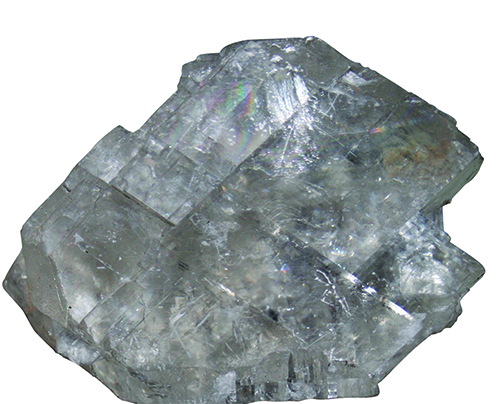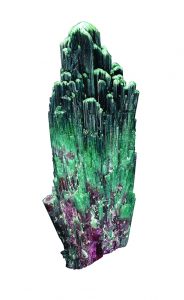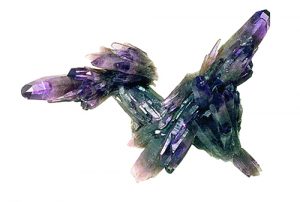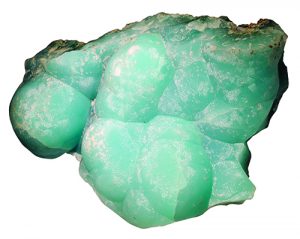
By Bob Jones
It’s common knowledge that the atoms of each element are made up of three main particles; protons, electrons, and neutrons plus a host of other particles. This series of On the Rocks is devoted to the three major atomic components, which are most important to the determination of what an element is, what its properties are, and how it behaves in chemical reactions.
For this discussion, the chemistry of minerals is based on the electrons located in the last most outer orbital and the next to last orbital. The electrons here are known as valence electrons. We need to know more about these two orbitals because they are what participate in a chemical reaction of their element by bonding or sharing electrons with other element’s electrons to form compounds.
Formed Through Bonding Electrons
Minerals form through the sharing of or bonding of outer electrons of the elements that make up a mineral’s composition. Understanding the role played by valence electrons and the actual chemistry of bonding or sharing of electrons to form a mineral is far more complicated than can be explained here. But my hope is you’ll have some grasp of how the minerals many enjoy come about. The goal of most elements is to reach a balance of eight electrons in an orbital.
A simple example of this is a water molecule. Chemically, it is two atoms of hydrogen joined with one oxygen atom. This happens because hydrogen only has one electron in its outer orbital, while oxygen has six electrons in its outer orbital. What is important here is the number eight. Every element, save for hydrogen and helium, tries to achieve a total of eight electrons in its outer orbital. They do this by either borrowing or sharing electrons with another element.

Chlorine (#17) for example has seventeen electrons around its nucleus. They are arranged 2-8-7. It will do almost anything to gain one electron to “close” its outer orbital to eight electrons. Enter sodium (#11) an alkali metal element with electrons arranged 2-8-1. The sodium bonds its one electron with chlorine’s seven electrons to form a very common mineral, salt!
This combining of the electrons of two or more different elements is the basis for the formation of our minerals. Of course, most minerals are not that simple. Far from it. Take a look at the formula for tourmaline. One scientist called tourmaline the “garbage can” mineral because one molecule of tourmaline can be made up of eight or so different elements, some of which contribute over two dozen atoms to that molecule. One of those elements is oxygen, which contributes over 30 atoms to a single molecule of elbaite tourmaline.
Orbital Path of Electrons
It is important to note that the electrons that surround any element’s nucleus do not align in circular orbits like planets around the sun. We only draw atoms that way so we can visualize and understand. If I write 2-8-8-2 representing the electrons around the nucleus of a calcium atom they really aren’t arranged that way at all. In fact, it is impossible to make a two-dimensional drawing of calcium’s electrons or any other element’s electrons, because they are more like a vibrating cloud or swarm of bees around calcium’s nucleus and they are apt to be anywhere at any given moment. But for this discussion, we will assume electrons are in set orbits or shells.
The Periodic Table of Chemical Elements can be considered as being in several groups related to electrons in their normal outer orbitals. The main group’s electrons in their outer orbital remain petty much set and do not shift orbitals when they participate in chemical reactions to form compounds, i.e. minerals.
A second group is the transition elements. The electrons in their last orbital or two will participate in chemical reactions and can vary in number. Take vanadium (#23) for example. Its outer orbital can have the normal two electrons or maybe three or even six electrons. Those extra electrons have used extra energy to transit to the outer orbital location. If they lose that energy, they go back to where they came from.
Balancing Out

University of Arizona
Now you see why trying to explain electrons and their orbits can get confusing, but nature is an orderly lady and everything balances out. The extra energy these electrons use comes from excess heat, sunlight or radioactivity that energizes those transitioning electrons to move or shift. We have learned we can cause those transition electrons to move by adding extra energy to them. When a colored gem is found with color that is not very good, we can irradiate it and change the color to our liking.
For example, a fellow I knew who was quite a genius, found that by irradiating colorless topaz he could give it a very handsome permanent blue color. Natural blue topaz sells for really good prices and no one could easily tell his irradiated blue gems were not natural. I saw this changed topaz being sold on a cruise ship I took to Alaska. It was being sold as “blue ice” topaz. The problem was the shop owner was not telling customers the topaz had been irradiated. Eventually, there was so much irradiated blue topaz around it was selling wholesale for five cents a carat.
The more active transition metal elements of the Periodic Table are located between scandium (#21) and zinc (#30). Yet, many other metals in the group can act as transition metal elements, especially those in the rare earth element group — in the long row listed separately at the bottom of the Table.
Iron is a good example of a transition metal element. Iron, number 26 on the Table has a normal electron arrangement of 2-8-14-2 with the outer orbital containing two valence electrons. But iron can also end up with three or even four valence electrons in its outer orbital. These extra electrons have picked up enough energy so they can transit from the next to last orbital to join the last orbital, joined with the oxygen we call iron, valence two, ferrous iron oxide, Fe2O3). With a valence of three, we call iron with oxygen ferric iron oxide (Fe304). Iron’s differing valences have an effect on what iron does in a mineral.
Trace Impurity Impacts
Even more interesting is what happens when iron is an impurity in a mineral like quartz. When this mineral forms in a solution it is very likely full of other elements like aluminum and iron, which can get trapped in the quartz structure as impurities. When iron is such a trace impurity with a valence orbital of two, the normally colorless quartz can be green. With an outer orbital of three valence electrons, the iron gives quartz a yellow color and it is called citrine.
With an orbital of four valence electrons, quartz takes on a lovely violet color, known as amethyst. In this state violet color in the quartz is unstable. That fourth valence electron was energized by radioactivity. But once the amethyst has formed and the fourth valence electrons lose energy in bright light, like sunlight, they move back to where they were originally, and the amethyst slowly becomes yellow citrine. Obviously, we need to pay attention to an element’s valence electrons when it comes to the color we see in minerals, especially gems.
There is another property we need to understand when it comes to electron orbitals. There are rules they have to follow, including how many electrons can end up or fit in an orbital. The first orbital of every element, except hydrogen with only one electron, has to have two electrons in it. No more, no less. This makes a closed orbital.
Closed orbitals never get involved in chemical reactions except in very odd circumstances. This explains why helium with two electrons in its first and only orbital does not participate in reactions. Hydrogen with only one electron is always active.
The second orbital around a nucleus of an atom can hold up to but no more than eight electrons. When that happens that second orbital is closed as seen in neon, (#10). Any additional electrons have to start another orbital. So, sodium with eleven electrons has to have a third orbital 2-8-1 and is very active, chemically. The third orbital can hold up to eight electrons for a total of 18, another noble gas argon. The elements with atomic numbers and electrons greater than eighteen keep adding orbitals and so on.
Complex Carbonate
Keep in mind, as we continue up the periodic table, orbitals that reach 18 electrons or 32 are also closed. Now you can see why the noble gases are not chemically active. Their last orbital with two electrons for Helium and eight electrons for all other last orbitals are always closed and not active.
One important secondary mineral group is the carbonates. The

DerHexer,Wikimedia Commons
variety of beautiful carbonate minerals includes minerals like calcite, aragonite, rhodochrosite, smithsonite and the copper carbonate azurite to name a few. Each of these beautiful minerals combines an atom of a metal element, be it copper, zinc, manganese, etc., with the carbonate radical, which is one carbon atom and three oxygen atoms, CO3. This radical is different from very common carbon dioxide which is one carbon atom combined with two oxygen atoms.
Carbon with a valence of four electrons in its outer orbital and oxygen with its two outer orbital electrons stabilize because the carbon takes in each of two oxygen orbital electrons to form CO2. But when one carbon atom joins with three oxygen atoms one of those oxygen atoms still has space for two more electrons. CO3 can join with zinc, copper, manganese or calcium each with a valence of two so they can combine nicely with the carbonate radical to form colorful and very collectible minerals.
The same is true for the OH radical where one hydrogen atom will be combined with only one oxygen atom to form the OH radical. This leaves the oxygen atom short one electron, which makes it very chemically active and will readily combine with other components to form stable minerals like hemimorphite Ca(OH)4. You might be interested to know that some scientists actually write the chemical formula for water as HOH to show a water molecule is the OH radical with the second hydrogen, HOH.
Keep in mind the explanations offered here are a gross simplification of very complicated mechanisms that create the molecules that make up our minerals. As you check the chemical formulae of various minerals keep in mind it is the action of valence electrons of each element that plays the major role in bringing together the elements that make up our much-loved minerals.













